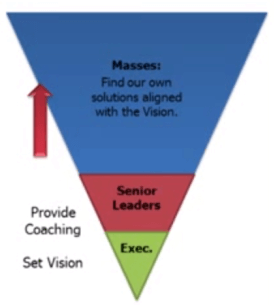Question: “How do you manage a professional?”
Answer: “You don’t!”
So goes the motto of one of the most high profile and successful examples of autonomous teams in the community sector, Buurtzorg in the Netherlands. The message is simple: if you believe in the motivation and tools your employees possess, giving them the freedom to execute their role will bring benefits for everyone.
Even some of the most traditional, top-down leadership organisations are getting on board with the idea of autonomous teams and front-line problem solving. Today, in Afghanistan, the Australian Army works on the principles of VUCA (volatility, uncertainty, complexity and ambiguity) to allow small teams to establish their own plans to meet goals.
I’ve spent the last decade thinking about, designing and creating autonomous teams. What I have learned is that it’s difficult; doing it well involves a wide range of skills – personal communication, project management, process breakdown and rebuild. I’ve failed more times than I’ve succeeded, but those failures have taught me lots about what makes autonomous teams tick, and why they are so important to the future of our sector. (At the DSC Beyond Unit Costs workshops in July, I’ll be going into more detail on a range of examples that I have seen that have worked in Australia and comparative fields overseas).
Autonomous teams have several important key characteristics, including:
- they are vision-based (responsive to clients)
- decentralised decision making, by those closest to clients
- trust, engagement and commitment in strategic decisions & direction
- shared & equal responsibility for organisational performance
- strong engagement with outside communities.
The evidence shows that shows autonomous teams lead to lower costs, more satisfied and engaged staff, and better outcomes for clients. So if we experience it ourselves, and there is solid research to reinforce the benefits, why aren’t we all working in autonomous, self-directed teams? There are two main reasons: one is technical, the other is cultural.
The technical reason that autonomous teams haven’t taken off in a significant way in Australia is because traditional IR and HR structures do not easily mesh with the principles of autonomous teams (and autonomous working in general). Whether viewing the challenge through an OH&S, performance management, team cohesion or productivity lens, existing HR principles create barriers rather than smooth the road.
The second reason is that creating, maintaining and supporting autonomous teams requires a tremendous amount of critical self-reflection from leaders. The essence of the leader’s role and value needs to be challenged to successfully build autonomous teams.
My experience is that the process of giving more autonomy to employees starts and finishes with self-critical leadership. All leaders can, with a single sentence, undo or reinforce hundreds of hours of process development. One of the greatest ironies in modern organisational development practice is the vast majority of leaders would prefer to have more autonomy and freedom. Yet rarely do leaders ask those they manage: “how can I give you more freedom to do your job to a higher standard?”
Our current management structures, processes and culture revolve around tasks and compliance to protect those at the pointed end of the pyramid. Building successful autonomous teams means inverting that pyramid, and redefining your role as a leader from a controller to a supporter. You need to be asking:
- What systems are you putting in place to allow your employees to practice their autonomy?
- What paradigms are you challenging that prevent your frontline workers from delivering truly flexible, person-centered services?
- Are you the tough-tackling midfielder that does the hard running, away from the spotlight, that lets your flashy forwards do what they do best?

If you are in a senior leadership role, you employ people in specialised fields to advise you on things like finance & accounting, human resources and IT. Every day you defer to the knowledge of these professionals, respecting the training, commitment and vision they have in their roles. So why don’t most leaders take the same approach with frontline staff? For some reason, we just don’t get the idea that a frontline worker could be the expert in helping a client achieve their goals, even if they’ve developed a rapport with that client after supporting them through thick and thin.
What everyone is quickly learning about the NDIS is that everything us up for grabs. Whatever we thought we knew is being challenged. If we are going to deliver services that match NDIS prices and meet client demand, the way we structure, build and maintain teams is no different.
Autonomous teams are the future, set them free.
:format(jpg))
